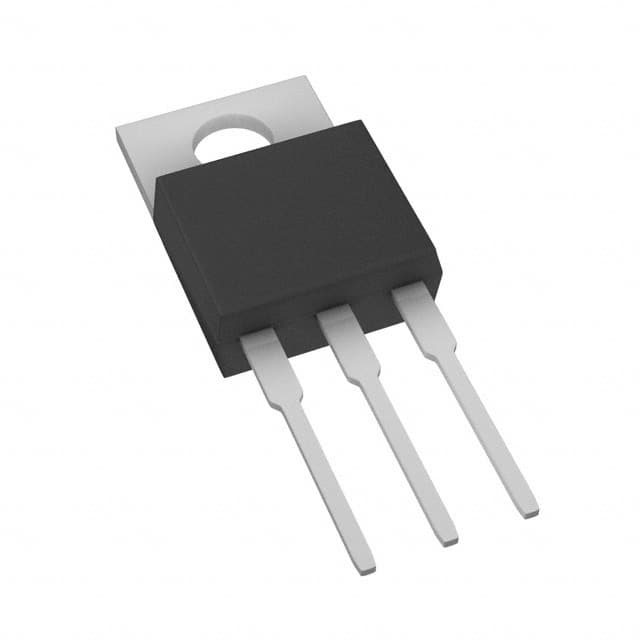Voir les spécifications pour les détails du produit.

SBL25L30CTHE3/45
Introduction
The SBL25L30CTHE3/45 is a semiconductor product belonging to the category of Schottky Barrier Rectifiers. This entry provides an overview of the basic information, specifications, detailed pin configuration, functional features, advantages and disadvantages, working principles, detailed application field plans, and alternative models of the SBL25L30CTHE3/45.
Basic Information Overview
- Category: Schottky Barrier Rectifiers
- Use: The SBL25L30CTHE3/45 is used as a rectifier in various electronic circuits, especially in power supply applications.
- Characteristics: It exhibits low forward voltage drop, high switching speed, and high temperature operation capability.
- Package: The SBL25L30CTHE3/45 is typically available in a TO-220AB package.
- Essence: It provides efficient rectification and power conversion in electronic circuits.
- Packaging/Quantity: The product is usually packaged in reels or tubes, with quantities varying based on manufacturer specifications.
Specifications
- Voltage Rating: 30V
- Current Rating: 25A
- Forward Voltage Drop: Typically around 0.55V at 12.5A
- Reverse Leakage Current: Maximum of 500µA at 30V
- Operating Temperature Range: -65°C to +175°C
Detailed Pin Configuration
The SBL25L30CTHE3/45 typically has three pins: Anode, Cathode, and Gate. The pinout configuration is as follows: - Anode (A) - Pin 1 - Cathode (K) - Pin 2 - Gate (G) - Pin 3
Functional Features
- High current capability
- Low forward voltage drop
- Fast switching speed
- High-temperature operation capability
Advantages and Disadvantages
Advantages
- Efficient power conversion
- Suitable for high-frequency applications
- Low power dissipation
- Compact design
Disadvantages
- Sensitivity to voltage transients
- Higher cost compared to standard rectifiers
Working Principles
The SBL25L30CTHE3/45 operates based on the Schottky barrier principle, where the metal-semiconductor junction allows for fast switching and low forward voltage drop. When a forward voltage is applied, the rectifier conducts current efficiently due to the absence of minority carrier storage time.
Detailed Application Field Plans
The SBL25L30CTHE3/45 finds extensive use in the following applications: - Switching power supplies - DC-DC converters - Reverse polarity protection circuits - Freewheeling diodes in inductive load applications
Detailed and Complete Alternative Models
Some alternative models to the SBL25L30CTHE3/45 include: - SS25L30CTHE3/45 - SBM25L30CTHE3/45 - SK25L30CTHE3/45 - SR25L30CTHE3/45
In summary, the SBL25L30CTHE3/45 is a Schottky Barrier Rectifier with high current capability, low forward voltage drop, and fast switching speed. Its efficient power conversion and suitability for high-frequency applications make it a popular choice in various electronic circuits.
Word Count: 414
Énumérez 10 questions et réponses courantes liées à l'application de SBL25L30CTHE3/45 dans les solutions techniques
What is the SBL25L30CTHE3/45 used for in technical solutions?
- The SBL25L30CTHE3/45 is a Schottky barrier rectifier diode commonly used for power supply, voltage regulation, and reverse polarity protection in various technical solutions.
What are the key specifications of the SBL25L30CTHE3/45?
- The SBL25L30CTHE3/45 has a maximum average forward current of 25A, a repetitive peak reverse voltage of 30V, and a low forward voltage drop, making it suitable for high-efficiency applications.
How does the SBL25L30CTHE3/45 contribute to power supply designs?
- The SBL25L30CTHE3/45's low forward voltage drop and high current capability make it ideal for minimizing power losses and improving overall efficiency in power supply designs.
Can the SBL25L30CTHE3/45 be used for reverse polarity protection?
- Yes, the SBL25L30CTHE3/45 is commonly employed for reverse polarity protection due to its low forward voltage drop and fast switching characteristics.
In what types of technical solutions is the SBL25L30CTHE3/45 commonly integrated?
- The SBL25L30CTHE3/45 is frequently integrated into automotive electronics, industrial equipment, and power management systems due to its high current handling capability and low power dissipation.
What are the temperature considerations for the SBL25L30CTHE3/45 in technical solutions?
- The SBL25L30CTHE3/45 is designed to operate over a wide temperature range, typically from -65°C to 175°C, making it suitable for demanding environmental conditions.
Does the SBL25L30CTHE3/45 require any special heat management in technical solutions?
- While the SBL25L30CTHE3/45 has good thermal performance, proper heat sinking or thermal management may be necessary in high-power applications to ensure reliable operation.
Are there any application notes or reference designs available for using the SBL25L30CTHE3/45 in technical solutions?
- Yes, manufacturers often provide application notes and reference designs to assist engineers in implementing the SBL25L30CTHE3/45 effectively in various technical solutions.
What are the advantages of using the SBL25L30CTHE3/45 over other rectifier diodes in technical solutions?
- The SBL25L30CTHE3/45 offers lower forward voltage drop, higher current capability, and faster switching compared to standard silicon diodes, resulting in improved efficiency and performance in technical solutions.
Can the SBL25L30CTHE3/45 be used in parallel configurations to increase current handling capacity?
- Yes, the SBL25L30CTHE3/45 can be used in parallel configurations to increase current handling capacity, but careful attention must be paid to thermal management and current sharing to ensure balanced operation.

